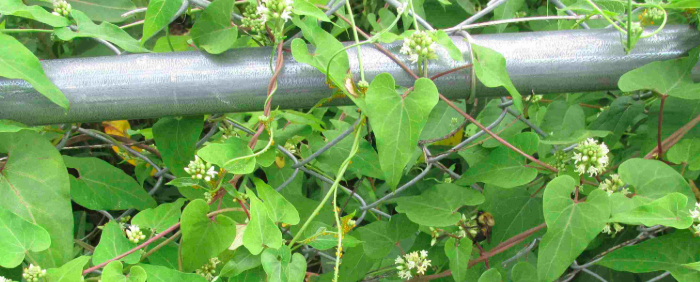
In France, three species of bindweed are found which belong in fact to 3 very distinct genera: the common bindweed – Ipomea purpurea – the field bindweed – Convolvulus arvensis – and the bindweed bindweed, of its small name Calystegia sepium .
Why is he in my garden?
The bindweed is a bio-indicator plant : it indicates a saturation of the clay-humic complex by nitrogen. It can also signal an excess of ammonium nitrate or organic matter, as well as compacted soil. Surprise? Yes, land too rich for fertilizer, and plentifully plowed favor him …
An unequal struggle
Some pour vinegar to the foot, others boiling water or cooking potatoes,
or solarize the land – which consists of covering the area with a thick black tarpaulin and leave it in place for several months. The father of the author of these lines strives for years to cover each foot of a box – empty cans, jars of jam which he carefully paints the glass parts … He has all kinds and all sizes – that it buries a little, letting the foot strive to seek the light during some seasons. What an expense of energy, for a result finally not very exciting! Bindweed 1 – my father 0 .
To fight, really?
” When a battle seems lost in advance, as much sympathize with the enemy. (My dad, when he finally understands the trick)
We may want to limit the development of bindweed , of course. However, it will always be difficult to overcome, and … And we want to tell you, as usual: often in the garden, it is better to do with that fight ! Incorporate bindweed into the design of your garden, compose, negotiate, use it for what it brings you, you will gain at least peace of mind !
Oh, what does the bindweed bring me?
- His roots improve your soil ! Not only does it tell you that your soil is compacted and too nitrogenous, but it helps to improve it, precisely!
- It is also a very melliferous plant that blooms from June to October and attracts many pollinating insects – including bees that adore its almond-flavored flowers.
- Finally, it is also a natural fertilizer : bindweed once dried and rid of its roots can be brought to the compost it will enrich nitrogen and various trace elements .
And so, how do I limit its development?
Apart from weeding by hand (which remains our preferred method, despite our penchant for lazy gardening ) there are no real miracle solutions. And besides, if we look at it well, in gardening solutionsoften proposed often aim to temporarily hide side effects, without addressing the causes …
The solutions? Your soil is rich and compact : straw, cover your soil if you have not already done so, and therefore cultivate greedy plants. The soil is alive – to find out more, read this nice article on the difference between earth and living soil – and it is only by agradant – the opposite of degrading – that you will arrive, little by little, to make roll back this damn bindweed.
For example, sow a rye / vetch mix in the fall that you’ll mow the next spring, leaving it on the ground, and grow carnation marigolds in green manure over the summer! Growing potatoes can also make it possible to roll back this damn wild buckwheat, and it’s super easy, especially under cover . In a general way, the space that you will take from him, pardon, that happy and flourishing cultures will graze to him centimeter by centimeter, will be more effective than your ravings in fury!
Thanks for this